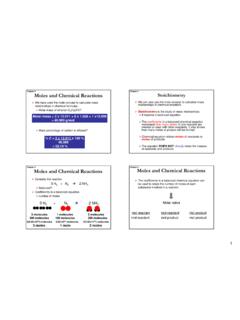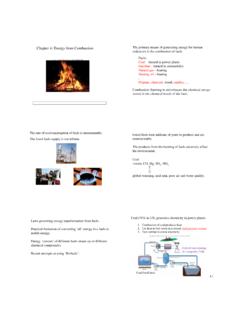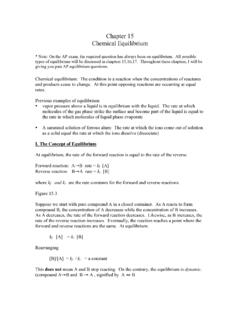Transcription of The Treatment Plan - SAGE Pub
1 The Treatment PlanThe Treatment plan is the road map that a patient will follow on his or herjourney through Treatment . The best plans will follow the patient for thenext 5 years where the relapse rates drop to around zero (Vaillant, 2003). Notwo road maps will be the same; everyone s journey is different. Treatmentplanning begins as soon as the initial assessments are completed. The patientmight have immediate needs that must be addressed. Treatment planning isa never-ending stream of therapeutic plans and interventions. It is alwaysmoving and changing. I have cowritten a thorough Treatment planning bookand computer program that should make Treatment planning easy: TheAddiction Treatment Planner(Perkinson & Jongsma, 2006a, 2006b).
2 Theplanner comes in two forms, as a book and as computer software. The bookand software help you write your Treatment plan with point-and-click simplic-ity and have been approved by all accrediting Treatment plan is built around the problems that the patient brings intotreatment. Within the Treatment plan is a problem list that details each prob-lem. The problem list comes at the end of the diagnostic summary. It tells thestaff what the patient will do in Treatment . It must take into account all of thephysical, emotional, and behavioral problems relevant to the patient s care,as well as the patient s strengths and weaknesses.
3 It must also address eachof the six dimensions of ASAM that you are Treatment plan details the therapeutic interventions, what is goingto be done, when it is going to be done, and by whom. It must consider eachof the patient s needs and come up with clear ways of dealing with each prob-lem. The Treatment plan flows into discharge planning, which begins fromthe initial Diagnostic SummaryAfter the interdisciplinary team members assess the patient, they meetand develop a summary of their findings. This is the diagnostic summary. Thisis where members of the clinical team the physicians, nurses, counselors,psychologists, psychiatrists, recreational therapists, occupational therapists,physical therapists, dietitians, family therapists, teachers, pastors, pharmacists,575 How to Build aTreatment 11/13/2007 5:25 PM Page 75and anyone else who is going to be actively involved with the patient s care meet and develop a summary of the patient s current state and needs.
4 Theteam members discuss each of the patient s problems and how to best treatit. From this meeting, the diagnostic summary is developed. This details whatthe problems are, where they came from, and what is going to be done aboutthem. It is much better to do this as a team. As you watch your team function,you will see how valuable it is to have many disciplines Problem ListThe Treatment team will continue to develop the problem list as thepatient moves through Treatment . New problems will come up and be addedor modified as conditions change. The problem list and Treatment plan mustbe fluid.
5 The list changes throughout Treatment as different problems comeup and others are to Develop a Problem ListA Treatment plan must be measurable. It must have a set of problems andsolutions that the staff can measure. The problems must be specific, notvague. A problem is a brief clinical statement of a condition of the patient thatneeds Treatment . The problem statement should be no longer than one sen-tence and should describe only one problem statements are abstract concepts. You cannot actually see,hear, touch, taste, or smell the problem. For example, low self-esteem is aclinical phrase that describes a variety of behaviors exhibited by the can see the behaviors and conclude from them that the patient has lowself-esteem, but you cannot actually see low are evidenced by signs (what you see) and symptoms (whatthe patient reports).
6 A problem on the Treatment plan should be followed byspecific physical, emotional, or behavioral evidence that the problem actuallyexists. List the problem, add as evidenced by or as indicated by, and thendescribe the concrete evidence you see that tells you that the problem of a problem list:Problem 1:Inability to maintain sobriety outside of a structured facilityAs evidenced by: Blood alcohol level of .23As evidenced by: The patient s family report of daily drinkingAs evidenced by: Alcohol withdrawal symptomsAs evidenced by: Third DWIAs evidenced by: History of third Treatment for addictionProblem 2:DepressionAs evidenced by: Hamilton Depression Rating Scale score of 29As evidenced by: Psychological evaluationAs evidenced by: Patient s two suicide attempts in the past 3 monthsAs evidenced by: Depressed affectProblem 3:Acute alcohol withdrawalAs evidenced by: Coarse hand tremorsAs evidenced by: Blood pressure 160/100, pulse 104As evidenced by: Restless pacing.
7 Self-report of strong cravingAs evidenced by: Profuse sweating; mild visual disturbances76 chemical DEPENDENCY 11/13/2007 5:25 PM Page 76 Once you have generated a problem list, you need to ask yourself what thepatient needs to do to restore him- or herself to normal functioning. Aperson who has a drinking problem needs to stop drinking and must learnthe skills necessary to maintain a sober lifestyle. A person who is depressedneeds to reestablish normal mood. A person who is dishonest needs to gethonest with himself or herself and others. Writing goals, objectives, and inter-ventions in a Treatment plan is made much easier for counselors by using TheAddiction Treatment Planneror The Addiction Treatment Planner WithDisk(Perkinson & Jongsma, 2006a, 2006b).
8 These plans conform to the high-est standards set by accrediting bodies such as the Joint Commission onAccreditation of Healthcare Organizations (JCAHO, 1988).How to Develop GoalsA goal is a brief clinical statement of the condition you expect to changein the patient or in the patient s family. You must state what you intend toaccomplish in general terms, and then specify the condition of the patientthat will result from Treatment . All goals label a set of behaviors that you wantto elicit in the should be more than the elimination of pathology.
9 They should bedirected toward the patient learning new and more functional methods ofcoping. Focus on more than just stopping the old dysfunctional on replacing it with something more of Developing GoalsInstead of:The patient will stop :The patient will develop a program of recovery congruent with asober lifestyle. (The patient is learning something different.)Use:The patient will learn to cope with stress in an adaptive of:The patient will stop negative self-talk. (The patient does notlearn something different or use something differently; the patient justavoids something that he or she already knows.)
10 Use:The patient will develop and use positive self-talk. (Now the patientlearns something different that is incompatible with the old behavior.)Use:The patient will develop a positive self-image. (The patient learnssomething new and more adaptive.)The patient or the patient s family must be the subject of each goal. Nostaff member or staff intervention should be mentioned. Identify one goaland condition at a time, and make each goal one of Goals1. The patient will learn the skills necessary to maintain a sober The patient will learn to express negative feelings to his or her The patient will develop a positive commitment to Treatment Plan77 Goals 11/13/2007 5:25 PM Page 774.



















